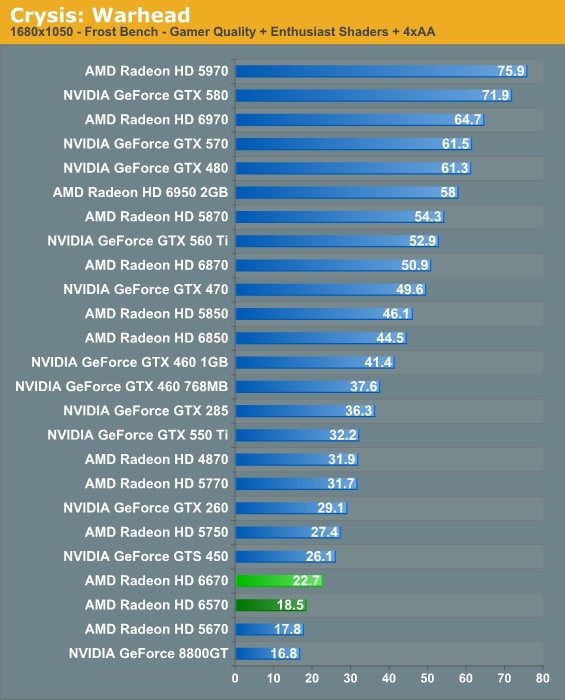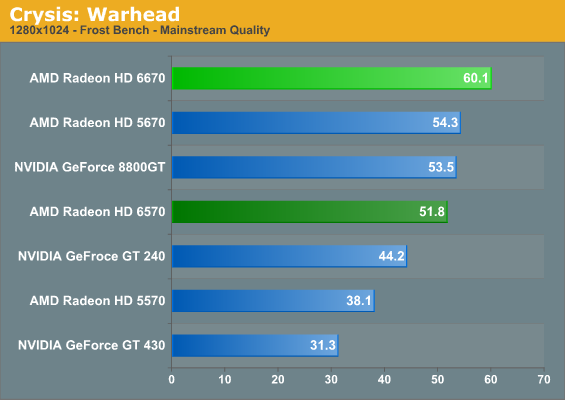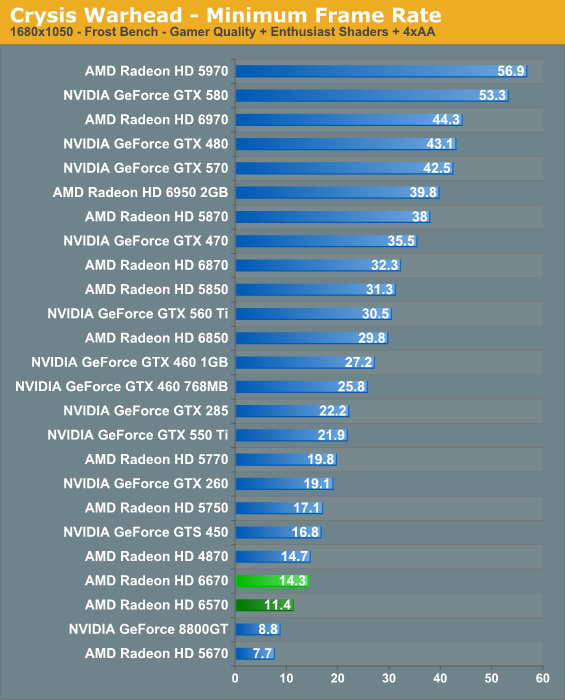AMD’s Radeon HD 6670 & Radeon HD 6570: Two’s Company, Sub-$100’s A Crowd
by Ryan Smith on April 19, 2011 12:01 AM ESTCrysis: Warhead
Kicking things off as always is Crysis: Warhead, still one of the toughest games in our benchmark suite. Even three years since the release of the original Crysis, “but can it run Crysis?” is still an important question, and for three years the answer was “no.” Dual-GPU halo cards can now play it at Enthusiast settings at high resolutions, but for low-end cards even Mainstream/Medium quality is about the best that can be achieved.


It takes a 5770 to crack 30fps in Crysis at 1680x1050, so the fact that the 6670 is only a bit over 20fps isn’t a big surprise. As far as performance at 1680 is concerned Crysis is a good summary of what we’ll see: too slow for 1680, and well behind the next tier of cards represented by the GTS 450 and the Radeon HD 5770/5750. However the 6670 does have a notable advantage here: with 1GB of VRAM it handles 1680 much better than the 512MB 5670, even if it’s ultimately too slow to be playable at these specific settings.
So for the kind of high settings we like to test at, it’s 1280 that’s going to be playable on the 6670, 6570, and similar cards. Once we drop down to 1280 and Mainstream quality the 6670 can crack 60fps, and with a bit of fiddling it should be possible to increase the quality of a setting or two without significantly impacting performance. Overall the 6670 has a 10% lead over the 5670 it replaces, which is a reasonable outcome for a game that’s largely (but not completely) shader-bound.
As for the 6570, it’s well-entrenched near the top of the pack. At 95% of the performance of the 5670 it does quite well, and the next-fastest modern card is the GT 240 which is quite some distance off. Against the 5570 it has a 35% lead, thanks largely to the use of GDDR5 instead of DDR3.
We have also thrown in the 8800GT into our 1280 results, just to offer a different look at performance relative to NVIDIA’s retired champion. It’s a good reference point for where we’re at now, versus what a $300 card did 3 years ago; and once we get to power/temperature/noise testing how better process technology and smaller GPUs have improved those metrics.


Looking at the minimum framerates, the relative ranking of our cards remains unchanged. The 6670 cements its lead over the 5670 here at 1680 thanks to its 1GB of VRAM, while at 1280 the gap narrows significantly to 5%. Meanwhile the 6570 loses ground on the 5670, with the 5670 taking a 10% lead.










53 Comments
View All Comments
ClagMaster - Tuesday, April 19, 2011 - link
The HD6670 is a nice upgrade for a 9600GT, both of which are 65W cards.I beleive, based on 240GT performance, that the HD6670 has about 40-50% more performace over the 9600GT.
This card has plenty of performance for games published 4 years ago.
arthur449 - Tuesday, April 19, 2011 - link
Last page, middle of fourth paragraph:"... the Radeon HD 5770 and GeForce GTS 450 are both regularly on sale for under $100 and are easily 30% faster than the 6770."
Shadowmaster625 - Tuesday, April 19, 2011 - link
Newegg has a sapphire 5750 for $103 ARhttp://www.newegg.com/Product/Product.aspx?Item=N8...
Best part is it can apparently be flashed into a 5770.
A 5770 curbstomps a 6670, by more than 50%.
Jasker - Tuesday, April 19, 2011 - link
Finally an actual comparison using an older card. I've been using my 8800 GTS 512 for years and yet to really see a game I could determine for sure was GPU bound (I have an old dual Operaton CPU). Thanks to this article I know I can almost definately see some games with todays mid range cards. Thanks!mosox - Tuesday, April 19, 2011 - link
you don't include the HD video quality benchmark but a load of TWIMTBP games instead.Read Tomshardware for a decent review.
Spivonious - Tuesday, April 19, 2011 - link
Agreed. These cards are not marketed towards gamers. They will more likely be used for media playback and casual gaming, not running Crysis.SlyNine1 - Wednesday, April 20, 2011 - link
No, I wouldn't buy a 6670 for someone thats just going to use it for media playback. There are much better options for that.casteve - Tuesday, April 19, 2011 - link
"The 5570 was the ultimate HTPC card, but the 6450 has dethroned it. "Except Ganesh is still in hiding.....so, you can't say it definatively.
I was going to say, these aren't gaming cards. Then I wandered over to the March 2011 Steam Hardware survey and found ~29% of users had 1280x1024 or less monitors. Yow.
The other humorous factoid was how the 6670 was the equivalent of the venerable 8800 GT; using 30W less in idle and half the power under load. Sort of a nice data point for progress.
But, the biggest missing piece to this article is the analysis for HTPC. How well do the 65xx/66xx score versus the 55xx/56xx/etc? How well do they implement 24fps?
Finally, Adobe is using gpu acceleration for some Photoshop/Lightroom/etc features. It would be nice (instead of Adobe's vague 'you can use your gpu card to accelerate' premise) to have some benchmarks for these lower tier cards to see what they actually do and whether a bottom end card is all you truly need for these apps.
Belard - Tuesday, April 19, 2011 - link
Agreed.Thing is, these new cards are quite usable for people on a budget - for gaming, or to do some gaming in an HTPC, which the 6450 cannot do. I still play games on my rather old 4670.
The video quality and feature set is what makes the 6000 series better than the 5000 and of course the GeForce cards which have severe HTPC / video output issues.
Spivonious - Tuesday, April 19, 2011 - link
Can the charts with noise levels please include the noise floor of the room, or of the system without the video card installed (which I'm assuming is around 41dBA in this case)? Also, can the distance of measurement be included? I would love to see measurements taken at two distances - one next to the case and one about 3-5 feet away to get the level at a normal seating distance.